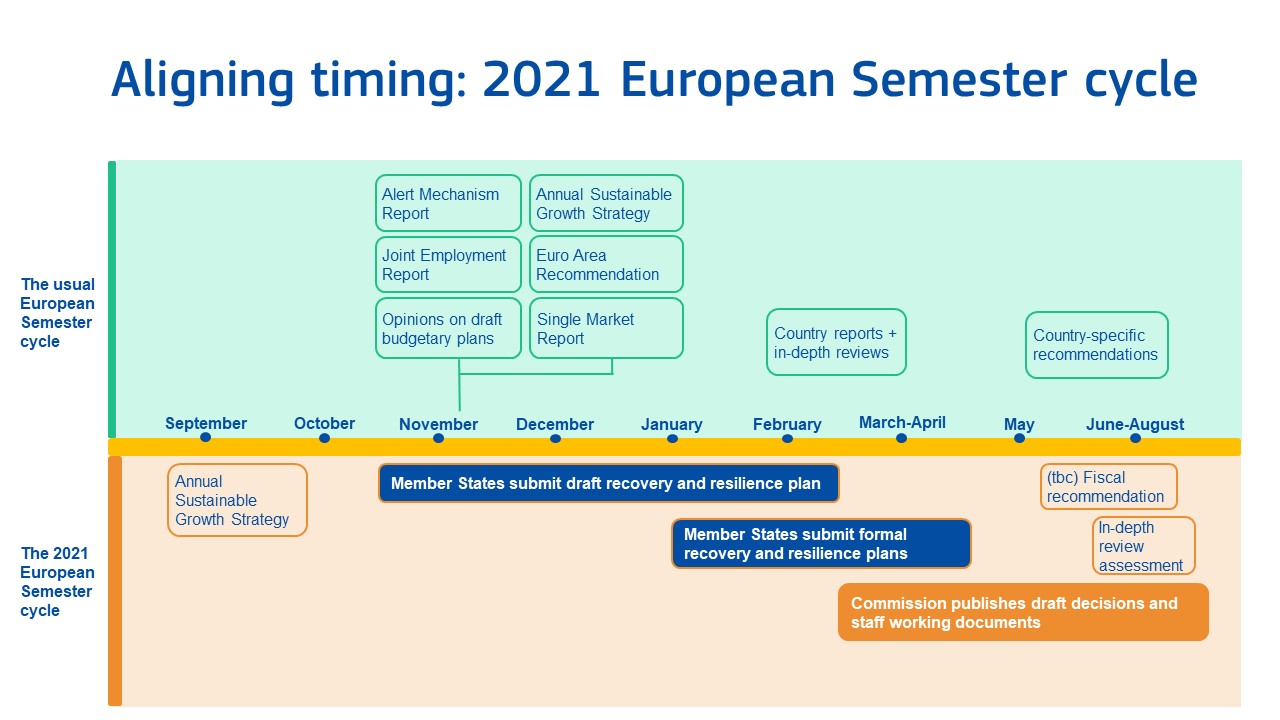Views: 67
In September 2020, the European Commission published the Annual Sustainable Growth Strategy-2021 (ASGS-21), together with the strategic guidance for the implementation in the states of the Recovery and Resilience Facility (RRF). The ASGS-21 is a follow-up of the previous year’s strategy with four main guiding principles: sustainability, productivity, fairness and macroeconomic stability; these dimensions will underpin the states recovery and resilience plans. The deadline is at the end of this April…
As is well-known, the member states have had opportunities to submit their draft RRP outlining national investment and reform agendas in order to benefit from the RRF already from the end of last year. The key recovery/resilient instruments are included as the main goals in the NextGenerationEU program, designed to help the EU-27 emerge stronger and more resilient from the current crisis. The RRF will provide about € 672-750 billion of loans and grants in financial support for the crucial first years of the recovery in the states.
Starting from 2020, the European Commission will set out every year the strategic guidelines for the annual sustainable growth strategies (so-called ASGS), that will guide the member states’ annual actions. More in:
https://www.integrin.dk/2020/10/25/post-covid-effects-on-modern-governance-and-political-economy/
Available assistance to the states
Besides, the Next Generation EU, the Commission intends to increase the budget of the Just Transition Fund from €7.5 to 40 billion, and proposes to reinforce the just transition scheme under InvestEU program. The MFF package includes a proposal for a public sector loan facility, which will mobilize about €25-30 billion; it means that the Just Transition Mechanism will have at its disposal at least €150 billion of public and private investment.
The EU’s flexible cohesion policy grants are available for municipalities, hospitals, and companies, through the member states’ managing authorities; here no national co-financing would be required, and this would involve €55 billion of additional cohesion policy funding between 2020 and 2022.
Besides, the Commission proposed a so-called “omnibus regulation” amending some sectoral ones, e.g. the European Agricultural Fund for Rural Development; the proposal includes €15 billion reinforcement to support states’ rural areas in making the structural changes necessary in line with the European Green Deal and achieving the EU’s ambitious targets in the new Biodiversity and Farm to Fork strategies. The omnibus regulation would amend sectoral regulations of the Framework Programme for Research and Innovation and the implementation of the specific program Horizon Europe for research and innovation.
A new health program (EU4Health) is aimed to strengthen health security and equip the member states against future health crises; the program is designed to support the states in the transition to better preparedness and the reinforcement of their health systems. According to the Commission’s proposal, EU4Health would run from 2021 to 2027, with a budget of € 9.4 billion, out of which €7.7 billion will be provisioned through the Next Generation EU.
Following guidelines…
The Commission also presented additional guidance to the member states on how best to present their RRP, together with a standard template for such plans. The deadline for submission of the RRP is 30 April 2021, although the states have been encouraged to submit their preliminary draft plans from already from October 2020; the early submission would help the states engage in a broad policy dialogue (including all relevant stakeholders) to prepare their RRP and to interact with the Recovery Task Force and DG ECFIN to discuss their draft plans.
The European Parliament and the Council quickly agreed on necessary legislation, so that the RRF becomes operational as of 1 January 2021.
There have been available Commission’s communications on the 2021 ASGS, as well as the guidance to the member states on RRP, and the draft template for RRP.
References to ASGS-21 in: https://eur-lex.europa.eu/legal-content/en/TXT/?qid=1600708827568&uri=CELEX:52020DC0575; on the guidance in: https://ec.europa.eu/info/files/guidance-member-states-recovery-and-resilience-plans_en; and on the draft-template in: https://ec.europa.eu/info/files/commission-staff-working-document-draft-template-recovery-and-resilience-plans_en.
Implementing RRF
During 2021, the national, as well as the Union’s ASGS, will focus on the implementation of the Recovery and Resilience Facility, the RRF, which is at the centre of NextGenerationEU. The RRF is the main EU’s recovery mechanism aimed to assist the member states to emerge stronger and more stable from the current crisis.
To benefit from the Recovery and Resilience Facility, national governments should submit their draft recovery and resilience plans, detailing national expenditure and reform priorities, in line with the EU policy requirements. These plans should also address the economic policy challenges found in the country-specific recommendations of recent years, in particular, in the cycles of 2020 and 2021.
The 2021 European Semester cycle is an exceptional one: it will be adapted to coordinate with the Recovery and Resilience Facility, RRF; publication of the Annual Sustainable Growth Strategy launched in 2021 cycle and following last year’s growth strategy is based on the European Green Deal and the concept of competitive sustainability (see table below).

EU member states have to submit national reform programs to the Commission -the deadline is the end of April 2021; together with the national recovery and resilience plans in a single integrated document, which will provide an overview of the states’ reforms and investments strategy by each state, in line with the objectives of the RRF.
Commission’s assessments of the national recovery and resilience plans for 2021will replace the European Semester’s country reports. Therefore, country-specific recommendations in 2021 will only concentrate on budgetary situation; generally, there will be no structural country-specific recommendations in 2021 for the states that have submitted recovery and resilience plans.
The Commission will continue to monitor and assess the risk of macroeconomic imbalances during the new Semester cycle, with a focus on emerging risks caused by the coronavirus crisis. More in: https://ec.europa.eu/info/business-economy-euro/economic-and-fiscal-policy-coordination/eu-economic-governance-monitoring-prevention-correction/european-semester/european-semester-timeline/european-semester-2021-exceptional-cycle_en
Thus, the member states which plans have not been finally adopted by the Commission, like e.g. the Latvian one, have a couple of weeks to make the things done… Just a reminder: the national plans shall include the EU’s “conditions”: i.e. about 60 percent of investments into digitalisation, green growth and measures to combat climate change!